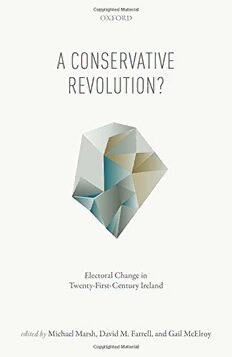
A conservative revolution? : electoral change in twenty-first-century Ireland PDF
Preview A conservative revolution? : electoral change in twenty-first-century Ireland
A Conservative Revolution? A Conservative Revolution? Electoral Change in Twenty-First-Century Ireland Edited by Michael Marsh, David M. Farrell, and Gail McElroy 1 3 GreatClarendonStreet,Oxford,OX26DP, UnitedKingdom OxfordUniversityPressisadepartmentoftheUniversityofOxford. ItfurtherstheUniversity’sobjectiveofexcellenceinresearch,scholarship, andeducationbypublishingworldwide.Oxfordisaregisteredtrademarkof OxfordUniversityPressintheUKandincertainothercountries ©OxfordUniversityPress2017 Themoralrightsoftheauthorshavebeenasserted FirstEditionpublishedin2017 Impression:1 Allrightsreserved.Nopartofthispublicationmaybereproduced,storedin aretrievalsystem,ortransmitted,inanyformorbyanymeans,withoutthe priorpermissioninwritingofOxfordUniversityPress,orasexpresslypermitted bylaw,bylicenceorundertermsagreedwiththeappropriatereprographics rightsorganization.Enquiriesconcerningreproductionoutsidethescopeofthe aboveshouldbesenttotheRightsDepartment,OxfordUniversityPress,atthe addressabove Youmustnotcirculatethisworkinanyotherform andyoumustimposethissameconditiononanyacquirer PublishedintheUnitedStatesofAmericabyOxfordUniversityPress 198MadisonAvenue,NewYork,NY10016,UnitedStatesofAmerica BritishLibraryCataloguinginPublicationData Dataavailable LibraryofCongressControlNumber:2016951322 ISBN 978–0–19–874403–0 PrintedinGreatBritainby ClaysLtd,StIvesplc LinkstothirdpartywebsitesareprovidedbyOxfordingoodfaithand forinformationonly.Oxforddisclaimsanyresponsibilityforthematerials containedinanythirdpartywebsitereferencedinthiswork. Foreword Michael Laver Ifwewanttounderstandhowandwhycitizensvoteindemocraticelections, andmostcertainlywedo,thenthegoldstandardisabeautifullydesignedand well-conducted academic election study. There are, of course, increasingly many ways to measure ‘public opinion’. These include ‘light-duty’ opinion surveysconductedformediaoutlets,puttingafewnewsworthyquestionstoa quotasampleofthepopulation,thesedaystypicallyviatelephoneorInternet polling. The dirty secret here is that response rates in such surveys are plum- meting, meaning that the set of respondents is become increasingly unrepre- sentativeoftheelectorateasawhole.Availablefixesrequirereweightingsurvey responsessothatatleasttheweighteddemographicsofthesurveymatchthose ofthepopulation,but,asresponseratessinkintothelowdouble-digitfigures (and even lower for some key demographic categories such as young voters), this reweighting becomes so aggressive that it greatly leverages any potential errors.Thisisonepossibleexplanationforwhyopinionpollsthesedaysoften seemtobegettingthingsbadlywrong.Therearealsoincreasinglysophisticated methods for analysing the vast volume of text generated every day on social media. More generally, there is an ever-expanding ‘big data’ environment in which more and more information is available about how ordinary people behave.Wewillhearmuchmoreofthesenewmethodsinthefuture,butfor now academic election studies remain the gold standard. These are based on genuinerandomsamplesofvoters,which,tiresomelybutnecessarily,involve contacting and recontacting sampled respondents until contact is made, acceptingnosubstitutes.Theyaskalotofrelevantquestions,usingaquestion- nairethatmaytakeuptoanhourtogetthrough.Manyofthosequestionshave beentriedandtestedovermanyyearsinmanycountries,resultinginawording that is very precise, and an unparalleled ability to measure changes within countries over time, as well as to make comparisons between many different countries.Theyareforthesereasonsveryexpensive,butthereisnosubstituteas avitalpartoftheinfrastructureofmodernsocialscience. ThisbookisbasedontheIrishNationalElectionStudiesof2002–11.Ireland camelatetotheelectionstudygame,asitcamelatetohavingawell-developed Foreword politicalscienceprofession.ThefirstIrishNationalElectionStudy(INES)was conductedin2002fundedbyanIrishgovernmentgrantthatwasinturnco- sponsored and triggered by a US-based funding agency, Atlantic Philanthro- pies.Mostdevelopeddemocracieshavedeployedstate-fundedelectionstudies since the 1950s, but the founding of the INES, of which the 2007 and 2011 election studies are a continuation, was of course better late than never. We nowhaveadevelopingtimeseriesthatsystematicallymeasuresdevelopments in Irish politics and a growing body of data that allow Irish voters to be comparedwithvotersinmanyotherdevelopeddemocracies. Substantivelythisisimportant,becauseIrelandisnocookie-cutterdemoc- racy. For much of the post-war era, there was a bitter civil war in living memory and a resulting fractious but intimate relationship with Britain, the former colonial power. There was an effectively unilateral declaration of independence resulting in a 1937 republican constitution written in close consultationwiththeCatholichierarchy.Thesingletransferrablevoteelect- oral system, which few political scientists outside Ireland really understand, incentivizes clientelist and parochial politics, as well as facilitating maverick local independents who have on occasion held the balance of power in government formation. There was substantial emigration of many of its younger and more enterprising citizens. No wonder Irish politics was ‘pecu- liar’toIreland,withvigorouscompetition,incomprehensibletomostforeign- ers,betweentwoconservativepartieswithsimilar-lookingeconomicpolicies but deeply differing cultural traditions rooted in the civil war, and a social democraticpartythatwastinyinEuropeanterms. Much,however,haschangedinrecentyears,atleastarguablymakingIrish politics less peculiar. The influence of the Catholic Church declined substan- tially,notleastbecauseofarelentlessseriesofabusescandals.Thebirthratefell off a cliff, though remains relatively high by European standards, reducing demographicpressuresforemigration.IrelandjoinedtheEU,enjoyedaCeltic TigerboommakingitbrieflyoneoftherichestcountriesinEurope,andthen adeep bustduringthe worldfinancialcrisis, requiring abailout and thetem- porarycedingofsubstantialfinancialautonomytoatroikaofexternalpowers (the International Monetary Fund, the European Commission, and the Euro- pean Central Bank).Fortunately, the political implications of at least some of these developments were charted by the INES, culminating in the subject of this book,the post-bust,dramatic, and arguably‘realigning’ electionof2011. We should be very thankful we have a ‘proper’ election study, not just a pot- pourriofopinionpolls,tohelpusnavigatethisimportantintellectualterritory. Self-evidentlygiventhedateofpublication,thisisnotan‘instant’bookon the 2011 election—How Ireland Voted 2011 (Palgrave 2011) has done a very goodjobofthatalready.Thebookthatfollowshereisthekeeper,themain- stream contribution, by many of the most accomplished and respected vi Foreword academicsworkingonIrishpolitics,whichdeploysthe2002–11IrishNational Election Studies to provide systemic scientific answers to many of the key questionsaboutthisimportantelection.Thistakestime,becausetheneedis nottodoitfastbuttogetitright,andtoprovidealong-standingcontribution to the professional literature. This is a book that will be read and cited for decadestocome. vii ’ Editors Preface Thegenesisofthisprojectwasaconcerntoprovideanauthoritativestatement onIrishvotingbehaviourintheearlydecadesofthetwenty-firstcentury.The three Irish National Elections Studies, covering the 2002, 2007, and 2011 elections, provide the research community with unparalleled access to the highest quality data on Irish citizens’ preferences and participation in the democratic process. The data gathered are particularly important in the case of the 2011 election, which was held in the midst of Ireland’s worst ever economic crisis, an election that produced dramatic electoral outcomes—a majorfocusofattentioninthisvolume. The ambition to provide an authoritative statement was influential in determining the mix of authors selected to contribute to this study—a mix ofseniorscholars(mostofthesefromoverseas)workinginconjunctionwith Irish-based political scientists. This was a truly collaborative effort. Draft papers were presented at two of the annual meetings of the Political Studies AssociationofIreland(PSAI)—bothoccasionsprovidingopportunitiesforthe authorstomeetandconferondraftchapters.WearegratefultothePSAIfor providing additional funding support to fly over some of our international contributors. FundingforthethreeIrishNationalElectionStudiescamefromarangeof sources.The2002INESwasfundedbyagranttoMichaelMarshandRichard Sinnott under the government’s ‘PRTLI/National Development Plan’. The 2007 INES was supported by an infrastructure programme grant awarded to Michael Marsh by the Irish Research Council for Humanities and Social Sciences (IRCHSS, the precursor to today’s Irish Research Council). Unfortu- nately, we were unable to secure research council funding for the 2011 INES. Instead this was funded from a series of sources: the Political Studies Association of Ireland (PSAI), Trinity College Dublin, University College Dublin,DublinCityUniversity,UniversityCollegeCork,Google,theOireachtas [Irish Parliament], and the McDougall Trust in London. Given the difficult nature of raising funding for the 2011 INES, it was run under the auspices of the PSAI, with Michael Marsh, David Farrell, and Gail McElroy acting as co-investigators, working closely with a panel of collaborators representing mostuniversitiesinIreland.
